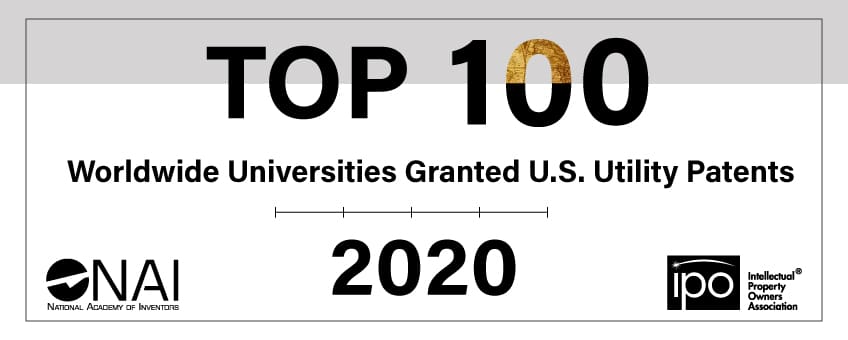MEDIA CONTACT:
Tracy Henion
Communications Director, MSU Innovation Center
ander1ta@msu.edu
Michigan State University has been ranked among the top 100 patent-granting universities worldwide — positioning MSU again as a longtime leader in supporting the vital role patents play in advancing research and innovation.
The 2020 report, recently released by the National Academy of Inventors (NAI) and the Intellectual Property Owners Association (IPO), uses data obtained from the U.S. Patent and Trademark Office (USPTO). MSU has ranked in the top 100 every year since 2013, the first year that the NAI began publishing the annual report.
“The institutions included in this year’s report are leading innovation worldwide through their encouragement of academic discovery and invention,” said Paul R. Sanberg, president of the NAI. “We are proud to collaborate with the IPO for the ninth consecutive year to highlight universities that have made critical contributions to society.”
Among MSU’s 47 patents issued in 2020, those especially significant in advancing new technologies include the following:
US Patent No. 10,700,378
“Slurry Formulation for the Formation of Layers for Solid State Batteries”
This method of making a lithium-ion solid-state electrolyte uses a unique slurry composition, which allows the fabrication of thin ceramic layers for solid-state battery applications. This technology, which enables the creation of batteries solid state batteries for a variety of transportation uses, is co-owned with the University of Michigan and the universities have partnered for commercialization via a startup company.
US Patent No. 10,541,118
“Methods and Apparatus for Microwave Plasma Assisted Chemical Vapor Deposition Reactors”
A novel process that allows continued monitoring of the local surface properties of diamonds as they are grown by microwave plasma assisted chemical vapor deposition, this advancement provides an opportunity to modify the manufacturing process as needed to meet various outcomes. The advancement allows companies to control the surface structure of diamond films to customize applications. MSU Technologies, the tech transfer and commercialization arm of the MSU Innovation Center, is in licensing negotiations with several companies for this technology.
US Patent No. 10,537,589
“Selection and Use of Lactic Acid Bacteria Preventing Bone Loss in Mammals”
Over 53 million Americans either have or at risk for developing osteoporosis, which occurs when the body loses too much bone, makes too little bone or both. Bones become weak and may easily break with a fall or in the most serious cases, a sneeze, or a bump. This technology, co-owned by MSU’s licensee, identifies specific bacteria to use as a probiotic for the prevention of bone loss.
US Patent No. 10,752,590
“Quinoline-Based Proteasome Inhibitors and Uses Thereof”
These novel compounds inhibit the proteasome by a unique mode of action than the FDA approved proteasome inhibitor drugs Velcade® (bortezomib) and Kyprolis® (carfilzomib). These compounds differ by exhibiting uncompetitive reversible inhibition rather than competitive inhibition. Research shows these compounds are effective against bortezomib-resistant Multiple Myeloma cells and have potential as a novel asthma treatment. MSU Technologies is discussing this technology with potential licensees.
US Patent No. 10,686,205
“Biofuel and Electricity Producing Fuel Cells and Systems and Methods Related to Same”
This is an innovative bacterial fermentation system that can be used to turn a waste product from biodiesel production (glycerin) into a precursor for bio-plastics. This green technology eliminates a waste product and coverts it to make an environmentally friendly plastic used in a variety of polyester plastics.
US Patent No. 10,570,409
“Transgenic Plants Produced With A K-Domain, and Methods and Expression Cassettes Related Thereto”
This technology is used to make high-yielding crop plants, such as corn, by making the plants smaller. Essentially, it helps the plants become adults faster, which means the plants don’t grow as much before adulthood. Smaller plants equate to more plants per acre, providing the capability to produce a higher yield.

